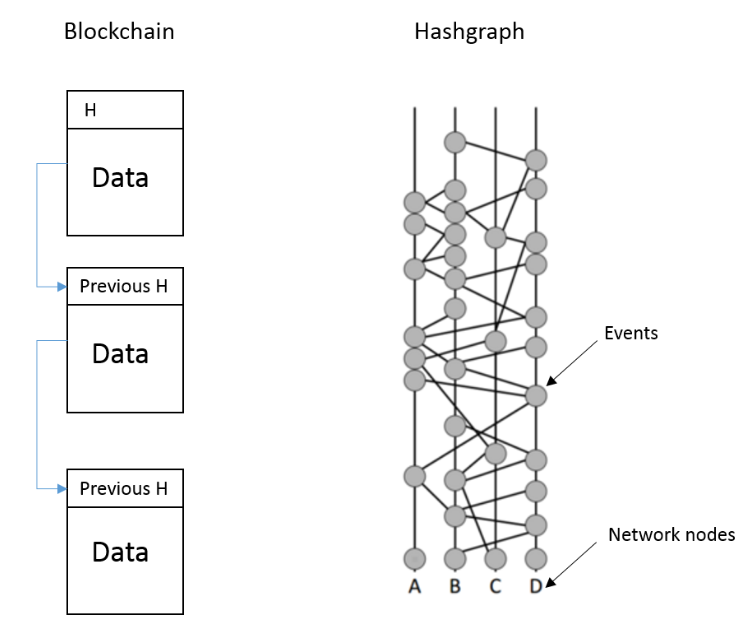
How the Consortium Blockchain Works
September 25, 2019
Corda and Real Businesses Built on Top of This Framework
August 23, 2019
The current popularity of blockchain technology, stemming primarily from its utility in a wide range of processes, has resulted in the appearance of various definitions of the concept. Depending on the context, blockchain may imply a distributed computer network, software supporting operations of the computers in the distributed network, or market of distributed networks and applications. Such versatility of definitions is an outcome of the concept’s applications in various fields and industries.
Blockchain has a distributed ledger technology at its core. Despite the proven effectiveness of blockchain, it still has its limitations in speed, scalability, synchronicity, which is the primary reason for several companies and individuals seeking the alternatives. Hashgraph is one of those potential solutions. The decentralized data structure of Hashgraph should provide higher levels of speed and reliability in comparison to Blockchain. Thus it is vital to assess the potential of the new technological concept.
Hashgraph operates on the basis of nodes and hashes. Nodes interact with each other by exchanging data and information. Hashes serve as proof for the occurrence of the mentioned transactions.

The transactions are the events that keep the hashes and transactions from the preceding two. Hashgraph network performs a voting algorithm that ensures security and the validity of the transactions. The nodes witness the transactions, effectively voting on their validity. The transaction is valid when at least 67% of nodes have witnessed and approved it. The resulting reliability and transparency of the process is amongst the underlying principle behind Hashgraph.
It is possible to compare Blockchain and Hashgraph based on three main aspects, namely data storage, data structure, and protocols. Blockchain implies storage of transaction records in a block, including current hash, timestamp, as well as the transaction from the preceding block. Hashgraph stores data in the form of an event, containing timestamps and transactions with the regular hashes. It is also possible to view the history of the transactions in a graph.
The process of data structure differs between Blockchain and Hashgraph. Blockchain technology uses nodes authorized for adding blocks to the chain of transactions. Hashgraph technology requires communication of the nodes, providing the information through the connections recorded in a graph. Therefore, Blockchain structures data in chronological order, while Hashgraph supports parallel transactions.

Blockchain utilizes two main consensus protocols, namely Proof of Work (PoW) and Proof of Stake (PoS) and their variations. PoW protocol implements mining through a series of complex mathematical calculations. The protocol rewards the miners solving the problems. The same process ensures the validation of blocks through safety algorithms. The protocol requires substantial amounts of time and energy. The PoS protocol implies the selection of the new block creators based on their respective wealth or stake (hence the name). Unlike the PoW, PoS does not provide the rewards, as miners commonly charge fees for transactions. The main benefits of PoS protocol are its higher speed and efficiency. At the same time, it is more centralized and, thus, more vulnerable from the standpoint of security.
Hashgraph uses Asynchronous Byzantine Fault Tolerance (aBFT) or gossip about gossip protocol. The protocol is focal for the system’s security and resistance to fraud. The aBFT protocol does not require additional nodes for its execution while occurring in three steps. First, the protocol divides the process into rounds with each round create after the event is able to connect at least 67% of the first events within the round to 67% of the node population. Second, the creation of the new round implies voting of the first several nodes to confirm the data contained in the first row of the preceding round. Such a process requires a connection of the mentioned nodes. Third, the collection of the 3rd round node answers occurs using the 4th round nodes for the achievement of the consensus.
Both technologies are DDoS resilient and ACID compliant (where ACID stands for atomicity, consistency, isolation, and durability). They rely on encryption of interaction and communication with hashes, as well as cryptographic signatures to prevent theft. In addition, adherence with security standards protects private information. In fact, the protocol utilized by Hashgraph prevents the influence of a single user or a small group of users on an entire system. Such an outcome is possible through the confirmation of the validity, history, and information of the event by the entirety of the users.
The possibility of Hashgraph and Blockchain competition became possible solely because of the clear benefits demonstrated by the former. Speed is the first and major advantage of Hashgraph. The technology allows instant sharing of data and information between the network participants. At the same time, Hashgraph also optimizes the process, allowing for cost reduction. The research has shown that it is possible to reach consensus within the Hashgraph network consisting of 32 computers in 3.0 seconds. A further reduction to 1.5 seconds and 0.75 seconds is possible, depending on the number of computers and regions. Hashgraph claims it is able to execute at 250 000+ transactions per second thanks to the property of parallel transactions.
Consensus timestamping ensures fairness and eliminates unfair decisions. Nodes are able to stop the transaction in case of the suspicious behavior with the subsequent reporting of malicious of illegal behavior. The majority of the nodes observe the transaction with the possibility to eliminate inaccurate decisions. Besides, there is no influence on the order of transactions like in blockchain (where miners are in power to choose the priority of transactions).
At last, the governance model, legal controls, stability, and regulatory compliance are among additional Hashgraph benefits.
Hashgraph technology also shows several drawbacks associated with its specifics. The primary drawback of Hashgraph is the possible corruption, resulting from lack of incentives that are present in Blockchain. The agreement of the majority required for the occurrence of the transactions adds a subjectivity factor related to the decisions of the specific network participants. Furthermore, the original Hashgraph also implies the possibility of inaccurate links and spread of data and information. Hedera Hashgraph has addressed such an issue through the implementation of non-aBFT consensus on top of the existing protocol.
The second drawback of Hashgraph stems from the potential lack of decentralization resulting from its intellectual property status. In particular, Leemon Baird has patented both algorithm and technology, retaining the rights for control, governance, and development of the network.
Efficient computational power of the nodes is crucial for execution of the smart contracts. However, Hashgraph does not have a requirement for the computational power of nodes. Thus, the technology is unable to become a Turing-complete environment. Hashgraph Hedera has addressed the issue by implementing the additional layer of nodes with PoS consensus, also adding computational power. Such an approach results in the processing of transactions in PoS blockchain protocol, rather than Hashgraph aBFT. Therefore, the process poses additional risks for security and anonymity of Hashgraph, since it will be necessary to process smart contract prior to sending it to Hashgraph for the verification process.
Finally, Hashgraph protocol has yielded comparatively high throughput in static and private settings. The speed, security, and fairness of Hashgraph also remained significant in the permissioned setting. However, the introduction of the technology in the public setting implies a range of issues, similar to those experienced by the majority of the modern blockchains. Moreover, the system will be less likely to maintain its performance and security levels in a public setting.
Hashgraph is an example of the technology that demonstrates strong potential for becoming an alternative to Blockchain. Such a possibility is the result of its higher speed, fairness, and efficiency. However, the drawbacks of Hashgraph related to security and decentralization imply further need for its improvement. Moreover, we are yet to see its work in a public setting.
While scalability remains the main concern the majority of the existing public blockchains, Hashgraph faces similar issues. At the same time, the novelty of the solution, as well as the emergence of new approaches in the field, reflects its vibrant growth. We forecast the appearance of the novel solutions in the nearest future.


